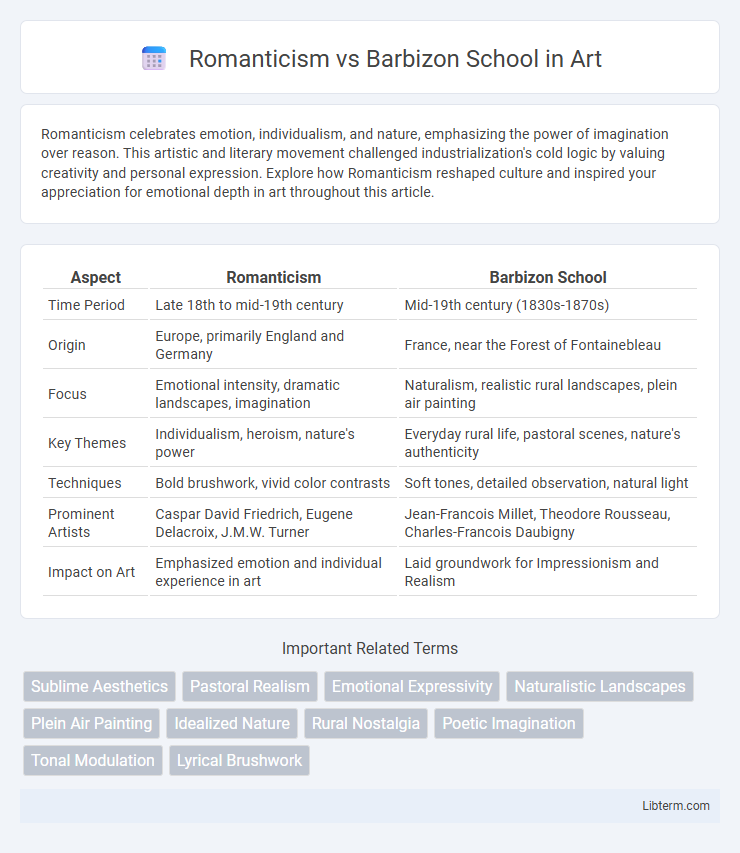Romanticism celebrates emotion, individualism, and nature, emphasizing the power of imagination over reason. This artistic and literary movement challenged industrialization's cold logic by valuing creativity and personal expression. Explore how Romanticism reshaped culture and inspired your appreciation for emotional depth in art throughout this article.
Table of Comparison
| Aspect | Romanticism | Barbizon School |
|---|---|---|
| Time Period | Late 18th to mid-19th century | Mid-19th century (1830s-1870s) |
| Origin | Europe, primarily England and Germany | France, near the Forest of Fontainebleau |
| Focus | Emotional intensity, dramatic landscapes, imagination | Naturalism, realistic rural landscapes, plein air painting |
| Key Themes | Individualism, heroism, nature's power | Everyday rural life, pastoral scenes, nature's authenticity |
| Techniques | Bold brushwork, vivid color contrasts | Soft tones, detailed observation, natural light |
| Prominent Artists | Caspar David Friedrich, Eugene Delacroix, J.M.W. Turner | Jean-Francois Millet, Theodore Rousseau, Charles-Francois Daubigny |
| Impact on Art | Emphasized emotion and individual experience in art | Laid groundwork for Impressionism and Realism |
Introduction: Defining Romanticism and the Barbizon School
Romanticism, emerging in the late 18th century, emphasizes emotional intensity, individualism, and the sublime aspects of nature, often depicted with dramatic, vivid landscapes and heroic themes. The Barbizon School, developing in the early 19th century France, focuses on realistic and detailed portrayals of rural scenes and natural settings, prioritizing direct observation over idealization. These movements contrast in their artistic goals: Romanticism seeks to evoke passion and imagination, while the Barbizon artists pursue naturalism and the truthful representation of everyday life.
Historical Context: Origins and Development
Romanticism originated in the late 18th century as a reaction against Enlightenment rationalism, emphasizing emotion, individualism, and nature's sublime aspects. The Barbizon School emerged in the mid-19th century within France, marking a transition towards realism by focusing on naturalistic landscapes around the Forest of Fontainebleau. While Romanticism prioritized dramatic and imaginative scenes, the Barbizon artists sought to depict ordinary rural life with precise observation and plein air techniques.
Key Philosophies and Artistic Goals
Romanticism emphasizes emotional intensity, individualism, and the sublime aspects of nature, aiming to evoke deep personal feelings and dramatic contrasts through imaginative composition and vivid color. The Barbizon School focuses on realism and the direct observation of nature, seeking to capture the tranquility and simplicity of rural landscapes with natural light and earthy tones. While Romanticism values imaginative expression and emotional impact, the Barbizon artists prioritize authenticity and the nuanced beauty of everyday scenes.
Major Artists and Their Contributions
Romanticism, with major artists like Caspar David Friedrich and J.M.W. Turner, emphasized dramatic landscapes and emotional intensity, using vivid colors and dynamic compositions to evoke awe and sublime experiences. The Barbizon School, led by painters such as Jean-Francois Millet and Theodore Rousseau, focused on realistic depictions of rural life and natural landscapes, pioneering plein air painting that influenced later Impressionists. Both movements significantly shaped art history by advancing landscape painting, Romanticism through imaginative grandeur and Barbizon through naturalistic observation.
Techniques and Artistic Styles
Romanticism emphasizes dramatic compositions, vibrant colors, and emotional intensity, often portraying sublime landscapes and heroic figures with dynamic brushstrokes and exaggerated forms. The Barbizon School adopts a more naturalistic approach, prioritizing realistic depictions of rural scenes and landscapes with softer tones, careful attention to light effects, and looser, more textured brushwork. Techniques in the Barbizon style focus on plein air painting to capture transient atmospheric conditions, contrasting with the studio-based, imaginative emphasis typical of Romanticism.
Representation of Nature and Landscape
Romanticism emphasized dramatic, emotional portrayals of nature, often highlighting sublime landscapes with intense light and shadow contrasts to evoke awe and spiritual reflection. In contrast, the Barbizon School focused on naturalistic, realistic depictions of rural landscapes and everyday scenes, capturing the subtle nuances of light and atmosphere in the forest of Fontainebleau. Romantic artists prioritized imaginative, idealized views, whereas Barbizon painters aimed for truthful representation and direct observation of the environment.
Emotional Expression vs. Realism
Romanticism emphasizes intense emotional expression and dramatic, often sublime landscapes that convey individual feelings and imagination. The Barbizon School prioritizes realism, capturing natural scenes with meticulous attention to detail and an authentic portrayal of rural life. This contrast highlights Romanticism's focus on subjective experience versus the Barbizon School's dedication to objective observation and naturalism.
Influence on Later Art Movements
Romanticism's emphasis on emotion and individualism significantly influenced later movements such as Symbolism and Expressionism by promoting subjective interpretation and dramatic compositions. The Barbizon School's focus on naturalism and plein air techniques paved the way for Impressionism, encouraging artists to capture light and atmosphere directly from nature. Both movements contributed foundational ideas that shaped the evolution of modern art by challenging academic conventions and inspiring new approaches to landscape and emotional expression.
Criticisms and Legacy
Romanticism faced criticism for its emotional excess and perceived lack of realism, whereas the Barbizon School was praised for its naturalistic approach but sometimes seen as limited in scope. Romantic artists prioritized dramatic, often idealized scenes, while Barbizon painters emphasized realistic depictions of rural landscapes and everyday life. The legacy of Romanticism lies in its influence on later movements like Impressionism, while the Barbizon School directly paved the way for plein air painting and the development of modern landscape art.
Conclusion: Lasting Impact on the Art World
Romanticism ignited a passion for emotion and individualism, profoundly shaping 19th-century art by emphasizing dramatic, imaginative scenes and heroic subjects. The Barbizon School shifted focus toward naturalism and realism, pioneering plein air painting that laid the groundwork for Impressionism and modern landscape art. Both movements collectively transformed artistic expression, influencing generations of artists and redefining the relationship between humanity and nature in visual culture.
Romanticism Infographic

 libterm.com
libterm.com